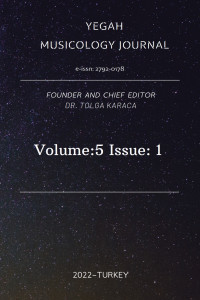KÜLTÜREL MİRASIN MÜZELER ARACILIĞIYLA HAYATA GEÇİRİLMESİ
Dünya halkları mirasıyla medeniyete entegre oluyorlar. Miras insanların ve ulusların tarihsel olarak neler yapabileceklerinin gerçek bir göstergesidir. Katılım mirası ve önemli yönünü oluşturan kültürel mirasının dönüşümü, bu alandaki araştırmanın oybirliği ile yapılmış bilimsel sonucudur. Bu süreçte müzeler çevirmenlerin ana formlarından birini oluşturuyor. Tarihsel olarak, müzelerin misyonu ve fikri tam da bu faktördü. Bu özelliklere göre, müzeler toplumda "bellek alanı", "bilgi tapınağı" gibi toplumsal işlevleri yerine getirmektedir. Müze sadece bir kurum olarak var olmadı, aynı zamanda geleneksel ve modern kültürel mirasın korunması ve modernizasyonu biçimlerinin ortaya çıkmasına katkıda bulundu. Modern küreselleşme bağlamında, ulusal ve etnik kültürlerin yok edilmesini hızlandıran, kültürel mirasın bu tehlikelerden ve risklerden korunması için müze etkinliğinin etkin kullanımı günümüzde büyük önem taşımaktadır. Kültürel mirasın modernizasyonu bu sürecin modern önceliğidir. Bu süreci destekleyen müzeler, faaliyetlerinde her türlü kültürel miras aktivizminin uygulanmasına özel önem vermektedir. Müzeler bugün yalnızca stereotipi olarak kabul edilen bir saklama alanı değildir. Modern müziğin kapsamının önemli ölçüde genişlemesi, yeni, modern biçimler oluşturulması için uygun koşullar yaratmıştır. Müzeler de aydınlanma, halklaşma ve gerçekleştirme merkezleri rolünü oynamaya başlamışlardır. Kültürel mirasın gerçekleştirilmesi, yani çağdaş kültürün aktif katılımıyla müze festivallerinin, müze şenliklerinin ve müze mekanizmasının kullanılması kültürel önem taşımaktadır. Yirminci yüzyılın ortalarına kadar, müzelerin maddi kültür mirasının bir nesnesi olduğu fikri onun soyut olmayan mirasını güncellemek için hazırlandı. Bu önemli faktör, UNESCO'nun Folklorun Korunması Tavsiye Kararını 1989'da 2003 tarihli Somut Olmayan Mirasın Korunması Sözleşmesinde de kötüye kullanıldı. Bu tez, müzelerin kültürel mirasın gerçekleşmesinin asıl amacı olarak anlaşılmasını mümkün kılmaktadır. Hamin dünyevi sorunların çözümü için müze yöntemleri ve formlarının kullanımı ve somut olmayan mirasın müzeleştirilmesi çok ilişkindir
Anahtar Kelimeler:
Miras, kültürel miras, müze, somut olmayan miras, müzeleştirme
IMPLEMENTATION OF CULTURAL HERITAGE THROUGH THE MUSEUMS
The people of the world are integrating civilization with their heritage. Inheritance is a real indication of what people and nations can do historically. The transformation of the inheritance of heritage and the cultural heritage inherent in her direction is the unanimous scientific result of the research in this area. In this process, the editors constitute one of the main forms of the translators. Historically, this factor had been the museum's mission and idea. According to these features, the mirrors fulfill social functions such as "memory space" and "information temple" in the society. The museum did not exist only as an institution, but also contributed to the emergence of forms of preservation and modernization of traditional and modern cultural heritage. In the context of modern globalization, the effective use of museum efficiency is one of the important thıngs today, to accelerate the destruction of national and ethnic cultures and to protect cultural heritage from these risks. Modernization of cultural heritage is the modern priority of this process. Those who support this process attach special importance to the application of all kinds of cultural heritage activism. The mirrors are not only a storage area that is considered to be a stereotype today. Significant enlargement of the scope of modern music has created favorable conditions for the creation of new, modern forms. The museums have also started to play the role of centers of enlightenment, publicization and realization. The realization of cultural heritage, which are the museum festivals, museum mechanisms, with the active participation of contemporary cultures, is of cultural importance. Until the middle of the twentieth century, the idea that the museums were an object of material cultural heritage was prepared to update its non-abstract heritage. This crucial factor has been abused in the UNESCO Recommendation on the Conservation of Folklore in 1989, in the 1989 Covenant on the Protection of the Non-Profitual Heritage.This thesis makes it possible to understand the realization of the cultural heritage of the museums as the main aim. The use of museum methods and forms and the museumification of intangible heritage have been urgent in solving this human problem
Keywords:
Heritage, cultural heritage, museum, intangible heritage, museumification,
___
- Avrupa Manzara Sözleşmesi Onayı.: Haziran http: //www.e- quanun.az/alpidata/framework/data/21/f_21861.htm.
- Brüksel Sözleşmesi 1874, // Warren Ansiklopedik Sözlük, Moskova: 1986.
- Quebec Bildirgesi: Yeni Musolojinin Temel Prensipleri //Museum 1985. №. 148.
- ICOM // resmi site URL'si:http://icom.org.ru. İnsanlığın Dünyasının Bildirgesi, Uygulama Rehberi, UNESCO / İyem 4). Kaulen. Mariya. Rusya’nın tarihi ve kültürel mirasının müzeyleştirilmesi. Moskova: 2012.
- Kültür Tarihi ve Teorisi, Bakü: Sabah yayınevi. 2010.
- Ravikovich Dmitri. Sosyal fonksiyonlar ve müzelerin tipolojisi // Müze bilimleri. Sorun teorisi ve Uygulaması, 1987.
- Stransky Zbinek. Sistemler ve müzecilik teorisi. Stockholm: 1981.
- Stransky Zbinek. DerBegriff der Museologic. Brno: 1971.
- Şmit. Fyodor. Müze sanatı ve gösterisi. Leningrad: 1929.
- Fyodorov Nikolay. Müzesi, okuryazarlığı ve yaşamı // URL: http: // dugward. ru / kütüphane / fedorov / fedorov_muzey.html.
- Başlangıç: 2018
- Yayıncı: Tolga KARACA
Sayıdaki Diğer Makaleler
CEMİL EKBER ŞİİRLERİNDE DEDE ŞEMŞİR
KÜLTÜREL MİRASIN MÜZELER ARACILIĞIYLA HAYATA GEÇİRİLMESİ
Üyesi Tolga KARACA, Seher Tetik IŞIK, Azerbaycan Dil EDİTÖRÜ, Yalçın ABDULLA, Özbekistan Dil EDİTÖRÜ, Batır MATYAKUBOV
AŞIK MUSİKİSİNİN SES-MAKAM SİSTEMİ ÜZERİNE
Köçerli İRADE, Kocharli İrada Tofig KIZI
İlgar İMAMVERDİYEV, Babek KURBANOV
AİLE, KADIN VE SOSYO-KÜLTÜREL PROBLEMLERİ
